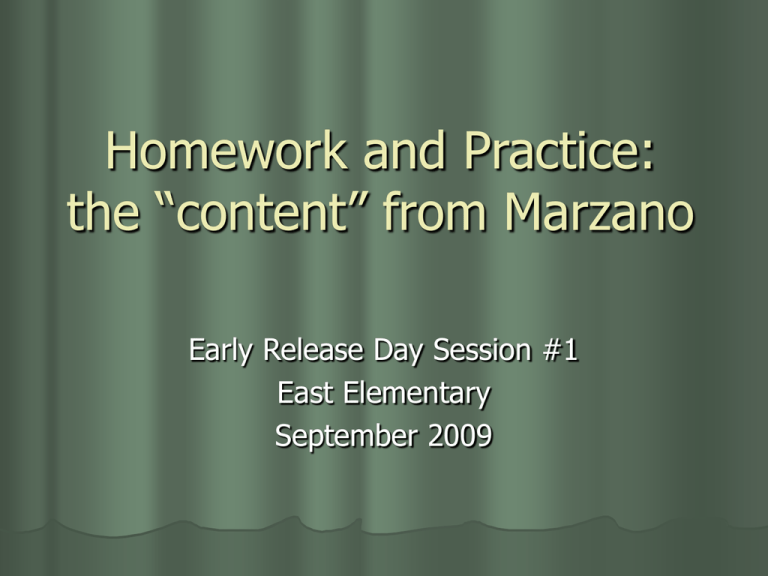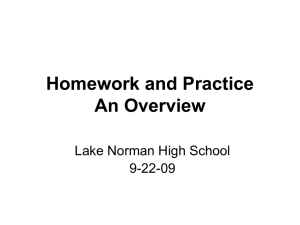Homework and Practice: the “content” from Marzano Early Release Day Session #1
advertisement

Homework and Practice: the “content” from Marzano Early Release Day Session #1 East Elementary September 2009 Purpose of Homework and Practice To deepen a student’s understanding To extend learning opportunities beyond the confines of the school day Two purposes 1. 2. Practice Preparation Source: Classroom Instruction that Works: Research-based Strategies for Increasing Student Achievement, Robert Marzano et.al – pp 60-71 Purposeful and Meaningful Homework Is an appropriate amount Requires minimal parental involvement Clearly communicates to students the purpose for the Homework or Practice Provides feedback to the student 1. Amount of Homework Different levels require different amounts of homework and practice - elementary, middle, high school Cooper’s Study reported the following gains: 24 percentile points: high school 12 percentile points: middle school 6 percentile points: elementary school Marzano et.al reported a 28 overall percentile gain from their meta-analysis study. NOTE: Although the percentile gain at the elementary is a single digit, other studies (Cooper and others) determine that purposeful homework at the elementary level is beneficial. It produces good study habits It fosters positive attitudes toward school 2. Parent Involvement in Homework Role of parent → minimal Encourage independent solving of content problems by students To facilitate homework, parents can: Reinforce the purpose of homework Provide a quiet and consistent place Reinforce and recognize the effort 3. Purpose of Homework Students need to know if the homework assignment is: • for practice • for preparation/elaboration For Practice Structured around highly familiar content for the student Reinforcing a familiar skill For Preparation or Elaboration Preparing students for new content Having students elaborate on new knowledge Articulate clear guidelines & expectations for the assignment Value, Benefit, Time-frame, Acceptable parent involvement 4. Feedback on Homework Homework with feedback (from teacher) 30% gain Homework without feedback 11% gain Vary the approach to feedback Specific comments from teacher Peer feedback monitored by teacher Written Verbal Rubric Let students know type of feedback to expect Ideas for giving feedback on hw: students give each other feedback, students keep track of their accuracy or speed, students keep a hw portfolio that teacher comments on once a week 5. Purposeful Practice: Helping students shape a skill or process While practicing, students should adapt and shape what they have learned. Allowing students time to “shape” skills builds their conceptual understanding. Mastery takes focused practice spread out over time. Have students practice fewer examples to develop a deep understanding vs. many examples that create a shallow understanding. 6. Determining Skills to Practice and How Much Practice Students need about 20 practice sessions before they grasp the new skill enough to use it effectively on their own Massed practice Distributed practice 7. Establish and Communicate a Homework Policy Students and parents need to understand the purposes of hw, amount of hw that will be assigned, consequences for not completing hw, and description of the types of parental involvement that are acceptable Sample Classroom HW Policy- clearly communicating your expectations (students and parents sign) ISS HW Policy 8. Students Charting Accuracy and Speed Speed- speaking a foreign language, estimating cost of purchases while standing in line at a store Accuracy- converting standard and metric units, learning scientific method, writing a good descriptive paragraph, indirect measurement

